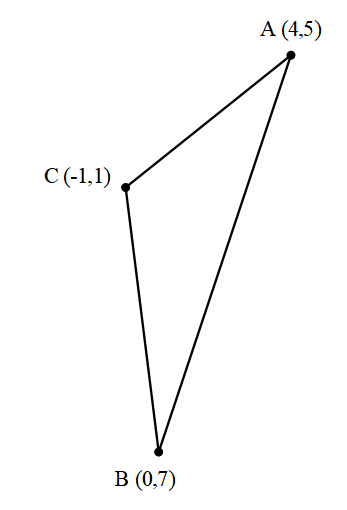
Find the area of the triangle whose vertices are (4,5), (0,7), (-1,1).
Answer
569.4k+ views
Hint: In order to solve this problem, we need to use the formula of area of a triangle using the vertices of the triangle. The formula for the area of the triangle is given by $S=\dfrac{1}{2}\left[ {{x}_{1}}\left( {{y}_{2}}-{{y}_{3}} \right)+{{x}_{2}}\left( {{y}_{3}}-{{y}_{1}} \right)+{{x}_{3}}\left( {{y}_{1}}-{{y}_{2}} \right) \right]$ , where, $({{x}_{1}},{{y}_{1}}),({{x}_{2}},{{y}_{2}}),({{x}_{3}},{{y}_{3}})$ are the coordinates of the three vertices of the triangle. The units of the area are assumed to be square units.
Complete step-by-step answer:
We need to find the area of the triangle. For the area of the triangle, we need to find the sides of the triangles.
For a better interpretation, we need to draw a rough sketch of the triangle.
The figure is as below,

Let the triangle be ABC with vertices A (4,5) , B (0,7) , C (-1,1).
Let, the coordinates of A be $A\left( 4,5 \right)=A\left( {{x}_{1}},{{y}_{1}} \right)$ .
Let, the coordinates of B be $B\left( 0,7 \right)=B\left( {{x}_{2}},{{y}_{2}} \right)$ .
Let, the coordinates of C be $C\left( -1,1 \right)=C\left( {{x}_{3}},{{y}_{3}} \right)$ .
The area of the triangle $\left( S \right)$ is given by $S=\dfrac{1}{2}\left[ {{x}_{1}}\left( {{y}_{2}}-{{y}_{3}} \right)+{{x}_{2}}\left( {{y}_{3}}-{{y}_{1}} \right)+{{x}_{3}}\left( {{y}_{1}}-{{y}_{2}} \right) \right]$
Where, $({{x}_{1}},{{y}_{1}}),({{x}_{2}},{{y}_{2}}),({{x}_{3}},{{y}_{3}})$ are the coordinates of the three vertices.
We can substitute the values and find the answer to the area of the triangle.
Substituting we get,
$S=\dfrac{1}{2}\left[ 4\times \left( 7-1 \right)+0\times \left( 1-5 \right)+\left( -1 \right)\left( 5-7 \right) \right]$
Simplifying further we get,
$\begin{align}
& S=\dfrac{1}{2}\left[ 4\times 6+0+\left( -1 \right)\left( -2 \right) \right] \\
& =\dfrac{1}{2}\left[ 24+2 \right] \\
& =\dfrac{1}{2}\times 26 \\
& =13
\end{align}$
Therefore, the area of the triangle is 13 square units.
Note: We need to note that we can start naming coordinates from any coordinates the answer we get will be the same. Even if we get the answer negative we only need to take the positive values because the area cannot be negative ever. Also, as we have not given the units we will assume the units to be square units.
Complete step-by-step answer:
We need to find the area of the triangle. For the area of the triangle, we need to find the sides of the triangles.
For a better interpretation, we need to draw a rough sketch of the triangle.
The figure is as below,

Let the triangle be ABC with vertices A (4,5) , B (0,7) , C (-1,1).
Let, the coordinates of A be $A\left( 4,5 \right)=A\left( {{x}_{1}},{{y}_{1}} \right)$ .
Let, the coordinates of B be $B\left( 0,7 \right)=B\left( {{x}_{2}},{{y}_{2}} \right)$ .
Let, the coordinates of C be $C\left( -1,1 \right)=C\left( {{x}_{3}},{{y}_{3}} \right)$ .
The area of the triangle $\left( S \right)$ is given by $S=\dfrac{1}{2}\left[ {{x}_{1}}\left( {{y}_{2}}-{{y}_{3}} \right)+{{x}_{2}}\left( {{y}_{3}}-{{y}_{1}} \right)+{{x}_{3}}\left( {{y}_{1}}-{{y}_{2}} \right) \right]$
Where, $({{x}_{1}},{{y}_{1}}),({{x}_{2}},{{y}_{2}}),({{x}_{3}},{{y}_{3}})$ are the coordinates of the three vertices.
We can substitute the values and find the answer to the area of the triangle.
Substituting we get,
$S=\dfrac{1}{2}\left[ 4\times \left( 7-1 \right)+0\times \left( 1-5 \right)+\left( -1 \right)\left( 5-7 \right) \right]$
Simplifying further we get,
$\begin{align}
& S=\dfrac{1}{2}\left[ 4\times 6+0+\left( -1 \right)\left( -2 \right) \right] \\
& =\dfrac{1}{2}\left[ 24+2 \right] \\
& =\dfrac{1}{2}\times 26 \\
& =13
\end{align}$
Therefore, the area of the triangle is 13 square units.
Note: We need to note that we can start naming coordinates from any coordinates the answer we get will be the same. Even if we get the answer negative we only need to take the positive values because the area cannot be negative ever. Also, as we have not given the units we will assume the units to be square units.
Recently Updated Pages
Master Class 12 Economics: Engaging Questions & Answers for Success

Master Class 12 Maths: Engaging Questions & Answers for Success

Master Class 12 Biology: Engaging Questions & Answers for Success

Master Class 12 Physics: Engaging Questions & Answers for Success

Master Class 8 Maths: Engaging Questions & Answers for Success

Class 8 Question and Answer - Your Ultimate Solutions Guide

Trending doubts
What is meant by exothermic and endothermic reactions class 11 chemistry CBSE

Which animal has three hearts class 11 biology CBSE

10 examples of friction in our daily life

One Metric ton is equal to kg A 10000 B 1000 C 100 class 11 physics CBSE

1 Quintal is equal to a 110 kg b 10 kg c 100kg d 1000 class 11 physics CBSE

Difference Between Prokaryotic Cells and Eukaryotic Cells




